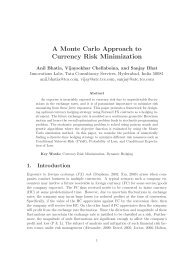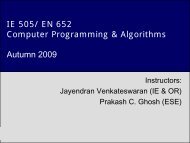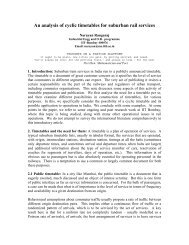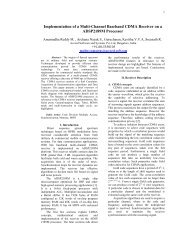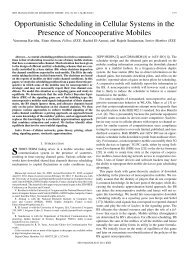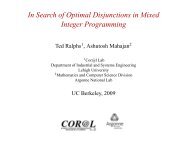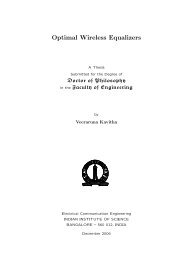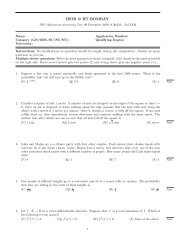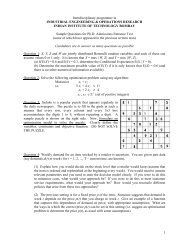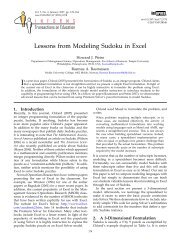PDF Link - Industrial Engineering and Operations Research (IEOR)
PDF Link - Industrial Engineering and Operations Research (IEOR)
PDF Link - Industrial Engineering and Operations Research (IEOR)
- No tags were found...
You also want an ePaper? Increase the reach of your titles
YUMPU automatically turns print PDFs into web optimized ePapers that Google loves.
The design of this supply chain relies on the fact that there is a viable stream oftraffic between the two areas, achieved by aggregation of a number of different goodsprovided by different customers. We use the term customer to refer to the shipper ofgoods who would use directly or indirectly, Concor, IR <strong>and</strong> other agencies for thepurpose of movement of goods. Our discussion revolves around how this stream ofgoods movement <strong>and</strong> its associated flows, are planned <strong>and</strong> managed effectively.3. Flows in the supply chain: As identified earlier, the main activities involved insupply chain management can be analysed in terms of flows. The various flows are to dowith physical flow of materials, the information flow, the flow of money or finance, <strong>and</strong>the transaction flow, identified, for example, in Tilanus (1997). These flows aredescribed in general, <strong>and</strong> are valid for all commodities that are h<strong>and</strong>led in this chain.3.1 Physical flow: The supply chain in question deals with three major flows that have tobe managed: the aggregation of goods at Tughlakabad, the movement of goods fromTughlakabad to JNPT <strong>and</strong> the disaggregation of goods at JNPT. The end points of thephysical supply chain under question are from factories or warehouses of individualshippers to the container h<strong>and</strong>ling area at JNPT. An important intermediate location isthe ICD (Inl<strong>and</strong> Container Depot) at Tughlakabad, where containers are aggregated <strong>and</strong>trainloads are formed [2].3.1.1 Consolidation (aggregation): There are two levels of consolidation. One is theformation of container loads by Concor or by freight forwarders or consolidators <strong>and</strong> theother is the formation of container train loads by Concor.Since the rail movement from Tughlakabad to JNPT is over a congested sectionof IR, principles of capacity utilisation dictate that traffic is moved in rake (full lengthtrain) loads only. The normal load carried on a container train is nine or ten compositeunits of 5 container flat wagons. Each container flat can carry one FEU container or twoTEU containers. A typical load combination could be of eleven FEUs <strong>and</strong> sixty seven 20TEUs, which therefore forms a train load of 45 container flats. A typical load couldcontain shipments from a variety of customers <strong>and</strong> a variety of destinations (from JNPT).3.1.2 Bulk movement: The movement of containers happens through train loadmovements on IR, as described above. The design of the integrated container flats <strong>and</strong>the associated braking system permits train movements at high speeds (up to 100 kmph,which is considered high in Indian operating conditions, given the condition of track,rolling stock <strong>and</strong> safe operating practices).The movement over about 1500 km between Tughlakabad <strong>and</strong> JNPT is via thefollowing major nodes on the IR network: Mathura, Kota, Ratlam, Vadodara <strong>and</strong> VasaiRoad. The fastest train on this section of IR (the Rajdhani Express) takes about 16 hourson the stretch between Tughlakabad <strong>and</strong> Vasai Road.3.1.3 Disaggregation <strong>and</strong> further movement: The disaggregation activities are thenh<strong>and</strong>led by the port, JNPT [1]. The containers in a typical train load may be bound for avariety of destinations on carriers. The movement of containers from JNPT to locationsin Asia, Europe, <strong>and</strong> other parts of the world is done by shipping companies <strong>and</strong>consortiums. This activity is outside the direct influence of the supply chain drivers inour case. These movements are controlled by worldwide shipping interests <strong>and</strong> is outsidethe scope of discussion here.



